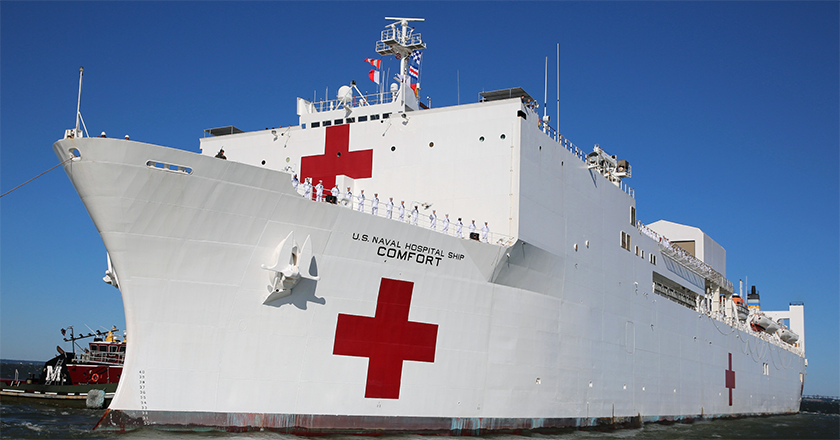In times of crisis, it’s more important than ever that we come together and work towards a common goal. During the COVID-19 pandemic, the world has seen healthcare facilities, governments, universities, utilities, and industries working together to help lessen the impact of this global crisis.
Emergency management plans no longer exist solely within a single municipality or organization. Now, every emergency management response from organizations across the country must take into account the entire general public. It’s not enough to have individual plans and responses, we must all work as a unit to fight COVID-19.
Team Based Response
You may have heard of tents being erected to create more space for testing or hospital beds. These temporary structures are excellent examples of how people across multiple industries come together to serve the public in times of crisis.
Insider reports on how these tents are being set up outside university medical centers, such as Columbia University Medical Center in New York City. As the healthcare workers work tirelessly to test and treat infected individuals, their governor, Andrew Cuomo, works to get them the supplies they need.
These tents are like a cross-section – they bring together emergency managers from hospitals, universities, and governments and unite them in a common goal: to end the spread of Coronavirus.
In addition to these cross-industry, team-based responses, numerous industries are contributing to this overarching goal in individual ways.
Universities Starting Off Strong
Universities across the country are closing their doors and sending students home early. Students will finish the semester out with online classes. But the response effort began before schools were closed.
Universities were contributing to the societal response by tracking travel in and out of the country, for example with study abroad students, and quarantining people accordingly. This helped to temper the spread of COVID-19 in early stages.
Healthcare – The Backbone of Relief
There is no denying the incredible impact that the field of healthcare has had during this crisis. Nurses and doctors are working overtime with limited resources, risking their own personal safety to treat patients. Read more about the stressors first responders face.
Hospitals are also creating plans to control the spread of COVID-19. The New York-Presbyterian Hospital updated their visitation policy on March 29th to say that no sick visitors will be allowed in the hospital and that visitors may be permitted in instances of life or death. They encouraged family members to keep in touch with loved ones virtually.
Other emergency plans include setting up temporary structures or bringing in facilities, like the USNS Comfort, to provide additional beds for patients infected by COVID-19.
Governments Working to Keep us Safe
Governments are working to keep us safe through policy. Mandating social distancing rules and shutting down state and local facilities are a step in the right direction towards limiting contact. The government is also working to protect people financially.
The US Department of Labor has increased unemployment payout rates. There will also be a stimulus payout to Americans starting in mid April. The goal of this financial support is to help Americans who have been laid off due to the massive shutdowns for social distancing.
First responders are also still working during this crisis. Police officers and firefighters are out there protecting the general public, even if it means putting their health at risk. Other federal employees, such as mailmen, are also still on the job.
Industries – Taking One for the Team
Many shops, restaurants, and companies have been temporarily shut down to help promote social distancing. Others remain open for limited purposes, such as take-out or delivery. This emergency response plan takes a toll on the economic stability of businesses, but it’s essential for the well-being of the general public.
On the flip side, there are many organizations who are still reporting to work because they are essential, such as grocery stores. These facilities have taken measures to promote social distancing such as taping off six feet apart at the registers, installing sneeze guards, setting aside specific times for senior citizens, and limiting the number of shoppers allowed in the store at once.
There are also many industries who are doing their part to help out by providing discounts to first responders, making masks or gowns for healthcare workers, or creating programs people can donate to, like local bookstores giving books to children.
Utilities Maintaining Power During a Crisis
Utilities are another essential industry, so workers are showing up amidst the COVID-19 crisis. Many utilities have made a plan to waive disconnections and late fees in order to help out people who are struggling during these unpredictable times.
Coming Together in Times of Crisis
It is evident that we all have a role to play during this crisis, whether it be staying at home and practicing social distancing, providing essential goods to the public, or serving on the frontlines of response. But no matter what our emergency plan is, one thing remains true: we must all work together to end this crisis.
The COVID-19 pandemic has garnered a truly cross-industry response. People from all walks of life are coming together (mostly in theory) to help stop the spread of this virus. It’s important that we all stick to our emergency plans and do our best to make this a successful response. The most important thing to remember is that we may be separated, but we’re not alone.








